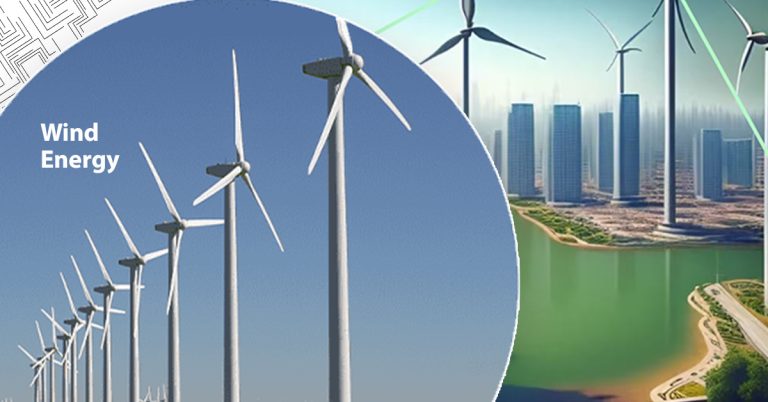20-Second Summary
Wind energy is electrical energy generated by wind energy turbines that convert the kinetic energy of the wind into mechanical energy that gets transformed into electrical energy by turbine generators.
This blog will explore the definition of wind energy, its advantages and disadvantages, its cost, functioning, different types, and its environmental impact on the world, with a specific focus on the USA.
What is Wind Energy? How is it Renewable?
Wind energy is the renewable electric energy generated by wind turbines to convert the kinetic energy of the wind into mechanical energy through turbine’s rotating blades, then into electrical energy via generators.
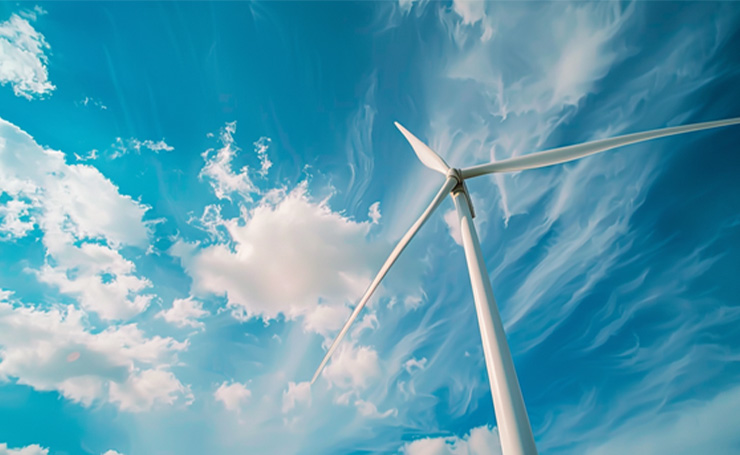
How Wind Occurs Naturally as a Renewable Resource
The wind is a major renewable resource that is used by wind turbines to generate electricity. Before looking at the functioning of wind turbines completely, let us have a look at the three main factors that produce this renewable resource, “wind.”
- The uneven heating of the Earth occurs as the sun’s energy heats the Earth, creating differences in the density and temperature, causing the warm air to move from areas of higher pressure to lower pressure.
- The air naturally moves from a region of high pressure to low pressure, which causes wind, and the large pressure difference produces strong winds due to the pressure gradient force.
- Coriolis Effect (Earth’s rotation) occurs due to the deflection, where, when the Earth spins, it deflects the path of the wind, preventing it from moving from high to low area pressures in a straight line by curving the wind.
Functioning of Wind Energy Turbines: Converting Kinetic Energy into Electricity
So basically, in order to convert the wind energy into electricity, wind turbines are the primary source.
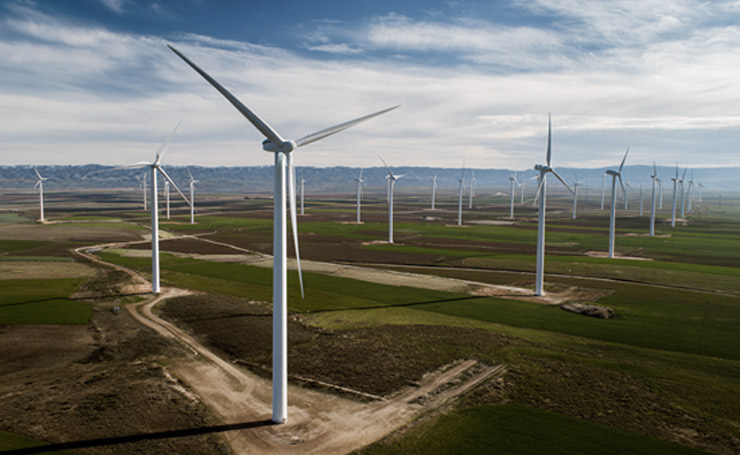
These turbines are made up of specific components that work together to transform the kinetic energy from wind into mechanical energy, and then electric energy.
Kinetic Energy → Mechanical Energy → Electric Energy
Each component of the turbine plays a specific role in this process.
Components of Wind Turbines
Below is a brief introduction of each component of the wind turbine, which makes it an electricity-generating source.
Rotor Blades
- The rotor blades are the components of the wind turbine that have been designed specifically to capture the wind.
- When wind passes over these aerodynamic blades, it causes them to rotate slowly based on the speed of the wind and the design of the blade.
Nacelle
Made out of materials like steel or composite materials to withstand the extreme weather conditions, a nacelle is the power house and brain of the wind turbine that converts the mechanical energy into electrical energy.
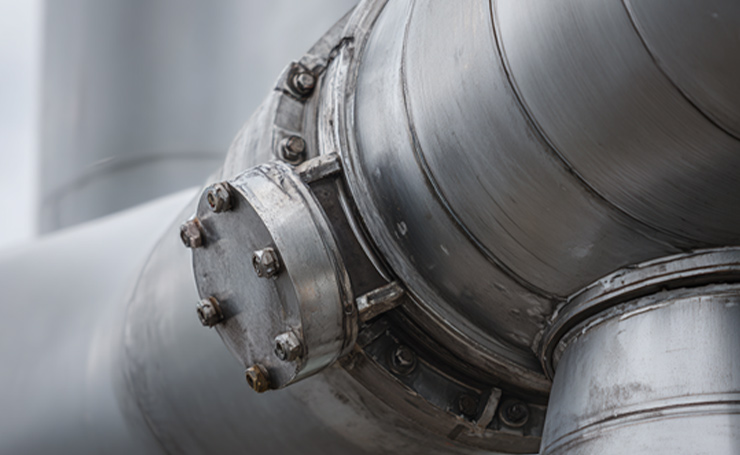
The nacelle has further components inside it:
- The gearbox converts the wind speed from the rotor blades into a suitable speed to spin the generator.
- A generator converts the received mechanical energy into electrical energy.
- The controller keeps the turbine in check, making sure it keeps functioning properly.
- The Yaw system helps to keep the nacelle position at an optimal level for facing the wind.
- Brakes are also a part of the nacelle that control the rotor blades in case of emergencies, like strong winds.
Gearbox
The gearbox enables an increase in the speed of the generator by connecting the slow-rotating rotor blades to the high-speed shaft of the generator.
- The rotor blade spins at 10 to 20 revolutions per minute (RPM).
- The gearbox increases this speed to about 1500 RPM, required by the generator for generating electricity effectively.
Generator
The generator is the main part of the wind energy system that converts the mechanical energy into electrical energy using electromagnetic induction.
- This part of the wind turbine is the last step of the renewable energy generation, which is sent to the grid.
Different Types of Wind Energy
Wind energy is divided into different types based on three factors:
- Location and scale of winds
- Types of turbine designs
- Combination with other renewable energy sources
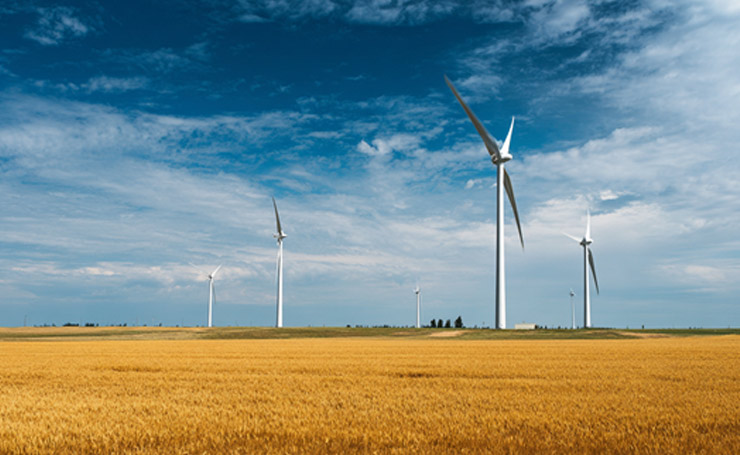
Wind Energy based on the types of Turbines
Wind energy can also be classified based on the different types of turbines, with the most common designs including the following:
Horizontal-axis wind turbines (HAWTs)
These come with a three-blade design that is used in commercial wind farms.
Vertical-axis wind turbines (VAWTs)
- These have a Compact design for small-scale areas.
- They can capture wind from any direction.
HAWTs vs VAWTs
Below is a side-by-side comparison of both designs to see how they differ from each other and where they are applicable.
| Feature | Horizontal-Axis Wind Turbines (HAWTs) | Vertical-Axis Wind Turbines (VAWTs) |
| Design Orientation | The rotor shaft is horizontal It faces the wind to capture it based on its direction. | The rotor shaft is vertical It can capture wind from any direction |
| Common Use | Large-scale, commercial wind farms (onshore & offshore) | Small-scale, urban, or residential setups |
| Efficiency | Higher efficiency (30–50%) due to better aerodynamics | Lower efficiency (20–35%) because of drag on blades |
| Startup Wind Speed | Requires higher wind speeds to start | Operates at lower wind speeds |
| Maintenance | More complexIt requires climbing towers to reach the turbine | Easy to maintainComponents are at ground level |
| Noise Level | ModerateThese can produce aerodynamic noise | QuietIdeally suitable for populated areas |
| Cost | Higher initial cost but better long-term output | Lower cost but limited energy generation |
| Applications Areas | Utility-scale wind farms | Rooftop or small community turbines |
Wind Energy based on the Location and Scale
Based on the location and scale, we can divide the wind energy types into four segments.
Onshore Wind Energy
The onshore wind energy is installed on land in hilly areas or open plains.
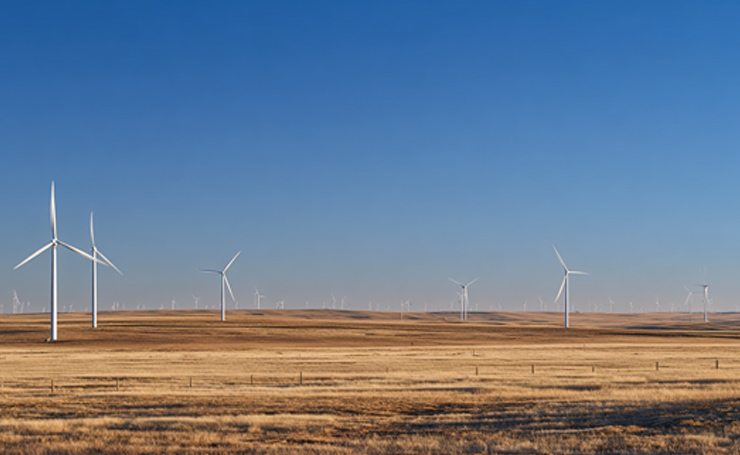
- The speed and consistency of the wind are moderate in these areas
- The typical energy output is around 25 to 40% of capacity.
- Their maintenance and installation costs are considerably lower than those of offshore wind energy turbines.
- Their accessibility is easier when it comes to repairing and logistics.
- These may be noisy for the nearby areas, and can be seen from the land, and can lead to habitat destruction for their installation.
- Their typical turbine size is smaller and is around 2 to 5 MW.
- There are more than 76,000 onshore wind turbines across at least 45 U.S. states.
Offshore Wind Energy
Offshore wind energy is installed in the oceans near the coastlines.
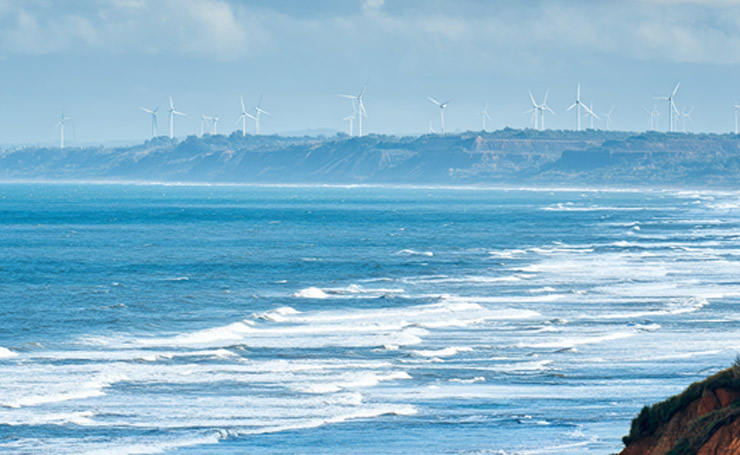
- The wind consistency and speed in these wind energy areas are higher and consistent due to the unobstructed ocean winds.
- Their energy output capacity is around 40 to 55% or more than that.
- Their installation and maintenance costs are really high due to marine conditions.
- Their accessibility for maintenance is difficult and also expensive based on their location.
- Since these are offshore, their visibility and noise do not impact the areas with population.
- These do have a potential impact on the sea life and also the sea birds.
- Wind turbines are also built on floating platforms in the ocean in deeper water to generate energy from offshore wind from places where fixed-bottom wind turbines cannot be installed
Distributed Wind Energy
The distributed wind energy consists of the small-scale, mini-wind turbines that provide energy to individual homes, farms, or businesses.
Wind Energy Combined with Other Renewable Energy Resources
Wind energy is sometimes also used in combination with other renewable energy or electricity generation methods using renewable energy sources like Solar Energy.

- These combinations create more reliable and integrated power systems, creating integrated forms of energy that are more reliable.
- This type of energy is known as Hybrid Wind Energy.
Advantages of Wind Energy
Wind energy has numerous benefits, making it a growing energy resource globally, especially in the USA. But along with the benefits, there are a few disadvantages as well that need to be considered.
Both have been explained below.
Advantages of Wind Energy
We all know that renewable energy generation is among the major wind power benefits. But other than that, there are many other benefits:
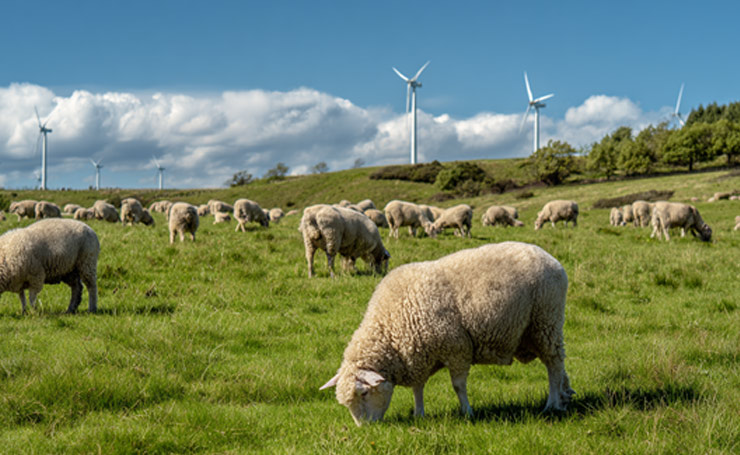
- Wind energy is clean energy, which means that it does not release any greenhouse gases that could pollute the air and cause smog, leading to a cleaner air quality.
- Wind energy works on the principle of wind, hence excluding the use of water for generating electricity, unlike traditional electricity generation methods, preserving the natural water resources.
- The impact on the environment is low because the areas where turbines are installed can be used for multiple purposes, such as agriculture and for grazing of the farm animals or the wildlife.
- The growing wind energy sector is a great source of generating new employment opportunities worldwide, not only improving the lifestyle of the communities in the wind energy farms, but also the economy.
- Wind energy has become one of the lowest-cost energy sources available, with costs continuing to decrease due to technological advancements.
- Once installed, the maintenance cost for the wind energy system is low compared to other energy sources, because it does not run on fuel.
- Wind energy can be merged with other energy types like hydropower or solar power.
- It can be integrated in different settings, like farms and ranches, or coastal communities.
- With the help of wind energy, communities that develop wind energy can use the revenue generated for school budgets or to reduce their taxes.
Disadvantages of Wind Energy
Wind energy also has some drawbacks that have been listed below:
- Wildlife, especially the birds and the bats, are affected by wind turbines a lot, where their collision with the turbines can kill them. To curb these challenges, the installation of the wind turbines should be avoided in the areas used by the birds for migration.
- The installation of onshore wind turbines requires land that can impact the environment due to deforestation for clearing the land to install the wind energy projects.
- Wind farms require significant space for turbines and service roads, which can impact local ecosystems and potentially lead to deforestation.

- Wind energy cannot work well in areas that receive low winds, hence it is not a cost-effective solution for such areas.
- Although most of the components of the wind turbine are made with aluminum, steel, and other structural components that are recyclable, the composite blades are made out of fiberglass, resins, and carbon fibers that are not easily recycled.
- Wind energy depends on the speed and capacity of the wind and wind turbines; hence, it cannot be a reliable source of fixed energy production.
- The upfront cost of installation of the wind energy farms, their storage, and grid connections and upgrades can be high.
- Grids that are weak may struggle to balance the upcoming wind energy with variable flow.
- The noise generated by the wind turbines could be uncomfortable for communities residing nearby.
- Some people dislike the wind farms due to their visual appearance, and they find them unappealing.
Wind Energy Uses & Applications in the USA
As per the U.S. Department of Energy (DOE):
- The country has over 70,000 onshore wind turbines across 40+ states
- These are producing nearly 10% of total U.S. electricity as of 2025
Below, we have listed some of the largest and influential onshore and offshore wind energy projects in the USA to highlight the key developments and renewable energy growth trends.
Onshore Wind Energy Projects in the USA
Below is the list of the onshore wind energy projects in the USA.
Alta Wind Energy Center
- Based in Tehachapi Pass, California, this project provides clean electricity across Southern California
- It has the energy capacity of 1,548 MW
- It powers over 450,000 homes through the Southern California Edison grid.
Roscoe Wind Farm
- With the energy capacity of 781.5 MW, this project is based in Texas
It supplies power to central and western Texas communities and industrial users via the ERCOT grid.
Shepherds Flat Wind Farm
- With a capacity of 845 MW, based in Oregon, this project provides renewable power to the Pacific Northwest grid
- It mainly serves Oregon and Washington
Meadow Lake Wind Farm
- This farm has a capacity of 801 MW
- It is based in Indiana
- It generates power for Midwest regional markets, supporting utilities in Indiana and Illinois.
Los Vientos Wind Complex
- The energy capacity is 912 MW, and it is based in South Texas
- It powers local Texas communities and commercial users to meet renewable energy targets in the state
Horse Hollow Wind Energy Center
- This center is based in Texas and has a capacity of 735.5 MW
It delivers clean energy to the Texas power grid - This energy is enough for nearly 220,000 homes
Cimarron Bend Wind Farm
- This wind farm is based in Kansas and has a power capacity of 599 MW
It provides renewable electricity to Kansas and neighboring states through the regional transmission network.
Offshore Wind Energy Projects in the USA
With an ongoing rapid expansion of the offshore wind sector, some projects are already operational, but some are also under construction. Their regional impact is highlighted in the table below.
| Project Name | Location | Capacity | Service Area |
| Block Island Wind Farm | Rhode Island Waters | 30 MW | Supplies power directly to Block Island residents. |
| Vineyard Wind 1 | Off the Massachusetts Coast | 806 MW | Generates enough energy for 400,000 homes in Massachusetts. |
| Coastal Virginia Offshore Wind (CVOW) | Virginia Coast | 2.6 GW (2,600 MW) | Will deliver power to up to 660,000 homes across Virginia. |
| Empire Wind 1 & 2 (Planned) | New York Bight / Off New York Coast | 2.1 GW (2,100 MW) | Planned to supply renewable power to New York City and Long Island. |
Wind power cost: LCOE, CAPEX, O&M, and Real Numbers
In order to understand the cost of wind energy, we need to understand the three key metrics:

Levelized Cost of Energy (LCOE) Costs
The LCOE represents the average cost per megawatt-hour of electricity produced over the lifetime of the wind project, including
- All capital costs
- Financing costs
- Operations cost
- And maintenance costs
CAPEX Costs
Capital Expenditure costs consist of the costs of turbine purchase, foundation construction, electrical infrastructure, grid connection, and project development.
Operations & Maintenance (O&M) Costs
These are the costs incurred for the operations and the maintenance of the wind energy system.
- O&M costs have declined dramatically for onshore wind due to the large turbines and the improved maintenance strategies.
- These have declined from approximately $35/MWh for late-1990s projects to around $11 to $15/MWh for modern installations.
Comprehensive Wind Power Cost Comparison (2024)
Below is a comprehensive breakdown of current wind power economics in the United States based on 2024 data.
| Cost Metric | Onshore Wind | Offshore Wind (Fixed-Bottom) | Offshore Wind (Floating) |
| LCOE (Levelized Cost of Energy) | $24–$75/MWh | $117–$230/MWh | $280–$320/MWh |
| CAPEX (Capital Expenditure) | $900–$1,800/kW | $3,500–$4,000/kW | $5,000–$10,000+/kW |
| O&M Costs (Annual) | $25–$75/kW-year | $80–$120/kW-year | $100–$150/kW-year |
| Capacity Factor | 38–47% | 41–50% | 40–50% (projected) |
| Project Size (Typical) | 50–300 MW | 500–1,500 MW | 500–1,000 MW |
| Turbine Size (Average) | 3.4 MW (2024 avg.) | 12–15 MW | 12–18 MW |
| Lifespan | 20–25 years | 20–25 years | 20–25 years |
| Installation Time | 12–18 months | 24–48 months | 36–60 months |
Future Cost Projections
Between 2030 and 2035, the cost projections say:
- Onshore wind LCOE is expected to remain stable at $30 to $50/MWh through incremental efficiency improvements
- Offshore fixed-bottom is projected to decline to $80 to $150/MWh as U.S. supply chains mature and projects scale up
- Floating offshore may reach $150 to $220/MWh with commercial-scale deployment and technology learning.
Policy, Incentives & Market Drivers in the USA
Wind energy in the U.S. continues to grow because of strong government support and financial incentives.
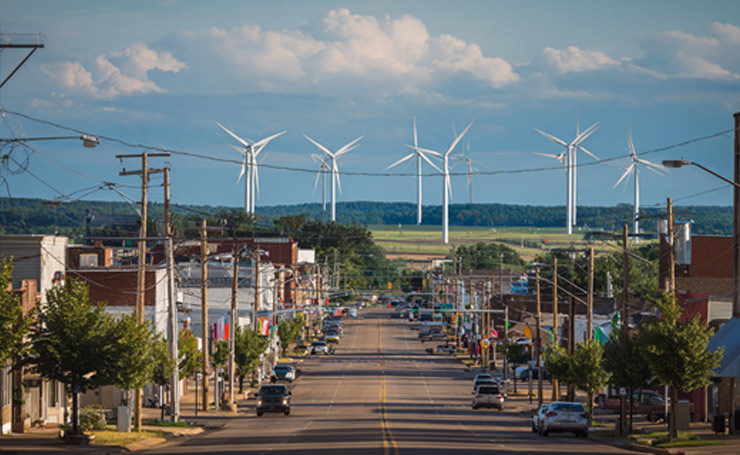
- The government support is making it easier and cheaper to build wind farms.
- Both federal and state programs encourage companies to invest in clean, renewable wind power.
Market Drivers for Wind Energy in the USA
Key market drivers for wind energy expansion and implementations include:
- Lower costs of wind energy production since 2010, as compared to fossil fuels.
- Big companies like Amazon and Google buy wind power to meet clean energy goals.
- Wind energy is being moved from rural to urban areas with investment from the US, making it another market driver for wind energy expansion.
- Employment opportunities are being created across the country, making it an ideal choice of energy.
- The government in the USA is pushing to implement wind energy to reach net-zero emissions by the year 2050, driving its expansion.
Policy and Incentives around Wind Energy in the USA
The policies and incentives for wind energy driven by the federal and state governments, with their impact, have been briefly described in the table given below.
| Policy / Program | Who Runs It | What It Does |
| Production Tax Credit (PTC) | Federal Government | Wind farm owners get a tax credit for every unit of electricity produced. |
| Investment Tax Credit (ITC) | Federal Government | Offers a 30% tax credit on the total cost of building new wind projects. |
| Inflation Reduction Act (IRA) 2022 | Federal Government | Extends the main wind energy tax credits for many years. |
| State Renewable Portfolio Standards (RPS) | State Governments | Require power companies to produce part of their electricity from renewable sources. |
| Offshore Wind Lease Programs (BOEM) | Federal / State | Allow developers to build wind farms in U.S. waters. |
Future Potential and Trends
Some future trends and projections related to wind energy are stated below:
- The turbines will become larger, having taller towers and longer rotor diameters to capture more wind for maximum power generation.
- The wind turbines will include lighter materials for blades for reduced noise production.
- Floating offshore wind turbines will expand more to maximize the utilization of the strong winds from deeper waters.
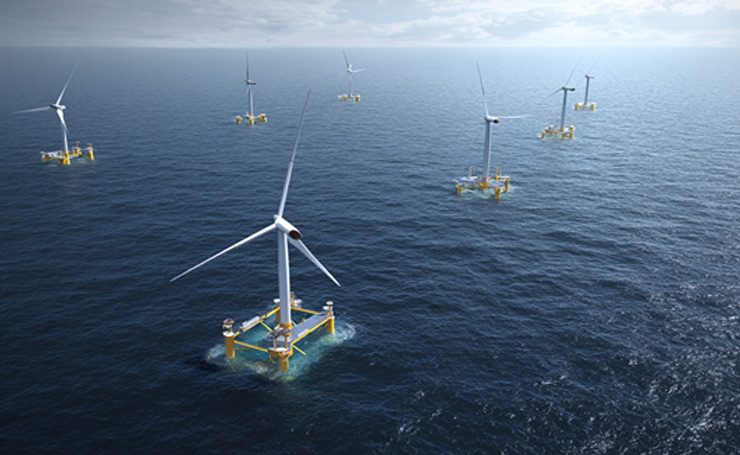
- The lifespan and efficiency of wind energy will be increased with smart technologies.
- Wind power is now projected to become a primary source of renewable electric energy through global collaboration among countries to create it into a global energy source.
- Job opportunities will be created with the continuous expansion of wind energy.
- A significant amount of CO2 emissions will be reduced by the year 2025 due to expanded wind energy.
Final Remarks
Wind energy is an essential source of renewable and clean energy, widely adopted across the USA and expanding globally. Modern wind turbines and onshore wind farms are helping meet energy demands for a sustainable environment, offering cost-effective electricity, preserving water resources, and supporting local communities through job creation and economic growth.
Along with other renewable resources like solar energy, wind power generation is a key solution for combating climate change and securing a sustainable future.
For more information, updates, and trends in the wind energy industry, keep visiting Green Energy Insights.
Frequently Asked Questions
What is the difference between onshore and offshore wind turbines?
Onshore turbines are built on land, while offshore turbines are installed in oceans where winds are stronger.
How wind turbines convert wind into electricity?
Rotor blades capture kinetic energy, spinning a shaft connected to a generator that converts mechanical motion into electrical power.
Do wind farms harm wildlife?
Yes, turbine blades can harm the birds and bats by hitting them.
What is the capacity factor of wind turbines?
The typical onshore capacity of wind turbines ranges from 35% to 45%, whereas the offshore capacity is typically 50–60%, depending on wind speed and turbine design.

